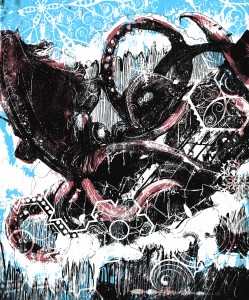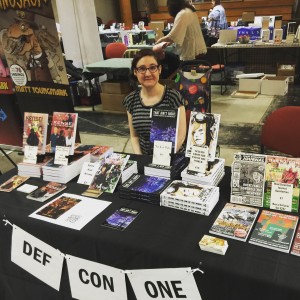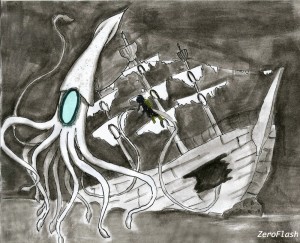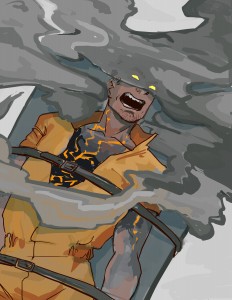An essay by Tom Hetson, as provided by Zach Bartlett
Art by Errow Collins
The Pneumatic Chron-Accurate Reminder Siren mounted on our front porch let out two harsh trills in rapid succession, signaling lunchtime. We wondered how it managed to keep time so regularly–most of a clock’s inner workings seemed to have been arranged on the exterior of the machine, so we often mused that all it could have had inside was white paint and a small pile of numbers. Our rooster Jubel didn’t find it nearly as interesting, having been made redundant by the siren’s single morning report, and had taken to just skulking around all day like a beaked house cat.
Our lunch that day consisted of rather soggy sandwiches due to a poorly-placed exhaust valve on the Professor’s Reciprocating Steam-Powered Bread Slicer & Sandwich Arranger. My sister and I had thought it was a fun change at first, and made a little game of trying to eat them before they fell apart in your hands, but its novelty had begun to wear thin, and my father was particularly on edge that afternoon. I’m not sure if it was just the wet bread that set him off, or if it was the culmination of several troubles we’d had since the Professor moved in, but when we were done eating, he made my job for the afternoon quite clear: “Go and collect the month’s rent from the Professor, and make sure he doesn’t try paying with some cock-a-mamey machine this time. Don’t nobody take those for trade in town and we sure as hell can’t eat them.”
Aside from the Reminder Siren and the Sandwich Arranger, previous months’ rent had been paid with items ranging from a Compact Coffee Pressure-Percolator, which transformed coffee beans and water into noise and vile brown foam, to a Hydro-Combustion Mechanical Boot-Putter, which the Professor had described as being, “like a cotton gin, only backwards and for your feet.” My father had expressly forbidden us from trying to use the Boot-Putter as directed, and after my sister managed to launch a boiled egg through our screen door while toying with its mechanisms, he decided we shouldn’t touch it at all.
I pulled on my own boots, took a mule named Shelly from the stable, and began to ride her along the series of pipes and hoses that trailed from our fields back to a large tank next to the spare barn the Professor was renting. Even though his barn was a good distance from our house, it would’ve been easy enough to find even if there weren’t pipes leading back to it due to the frequent plumes of smoke it emitted. Fortunately for him, that day they were coming from the chimney.
The pipes leading to his barn were part of his down payment when he took up residence, a Syncopated Emission Depressurized Cooled Steam Distribution Array he’d been looking for a test farm to properly implement. I didn’t know how cooled steam was different from water, or how a syncopated thing was different from a normal irrigation system, but I’d heard him assure many potential customers that his versions were better. I didn’t doubt him, accepting youth that I was, but the only difference I could really see was that his versions always had more gears and springs and such on the outside.
When I arrived at the Professor’s barn, he was already out front, making some sort of adjustment to his own Reminder Siren. Once he noticed me he stopped and gave an enthusiastic wave in my direction. He was wearing a shabby overcoat and a pair of brass goggles with dark, thick-looking lenses. The bottom half of a smile was visible beneath his formidable mustache, which wouldn’t have looked out of place on a face twice as wide as his own.
“Thomas, my boy!” He bellowed, though I wasn’t more than 20 feet away. “What’s the good word this brisk, energizing afternoon?”
“Rent,” I said, not yet sharp enough to understand such turns of phrase.
The Professor seemed delighted by my youthful bluntness. “Getting right to business–no fiddling around! That’s an admirable quality in a man.” He made his way over to me with his usual stride, which always gave the impression that he was practicing to lead some odd parade. “Come over to the workshop and hitch the horse out front,” he said, patting Shelly on a haunch. “You’re not going to believe the marvelous machination I’ve just devised! How’d you like to be the first to test it out for me?”
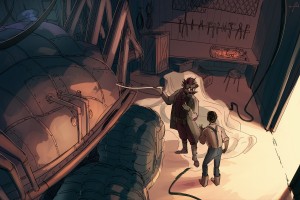
I’d seen him in town when he was barking for his inventions before, so I knew what to say in order to advance the routine.”But what does it do?” I even raised my arms out to either side in emphasis.
To read the rest of this story, check out the Mad Scientist Journal: Summer 2016 collection.
Tom Hetson is the de facto assistant and biographer of Professor Quinceton Rutward, who is the inventor of such steamatic devices as the Theatricated Cloth-Raiser, the Hydrogravitic Crenellated Rain-Collecting Funnelbarrel, and the (s)Hotgun. Professor Rutward’s inventions have been showcased at the Albano County Eighth Annual Spring Fair as well as the Albano County Eighth Annual Fall Fair.
Zach Bartlett has had his short fiction in anthologies from Wildside Press and Sapiosexual Publications, co-written two Fringe Festival plays, and performed comedy shows in Providence, Rhode Island. He regularly writes and performs on stage with Esoterotica in New Orleans. You can find more of him–not in that way–online at http://zachbistall.wordpress.com
Errow is a comic artist and illustrator focused on narrative work themed around worlds not quite like our own. She spends her time working with her partner on The Kinsey House webcomic and developing other comic projects when she’s not playing tag with her bear of a cat. More of her work can be found at errowcollins.wix.com/portfolio.
“Steam & Hot Air” is © 2016 Zach Bartlett.
Art accompanying story is © 2016 Errow Collins.
An audio version of this story is available through Gallery of Curiosities.

